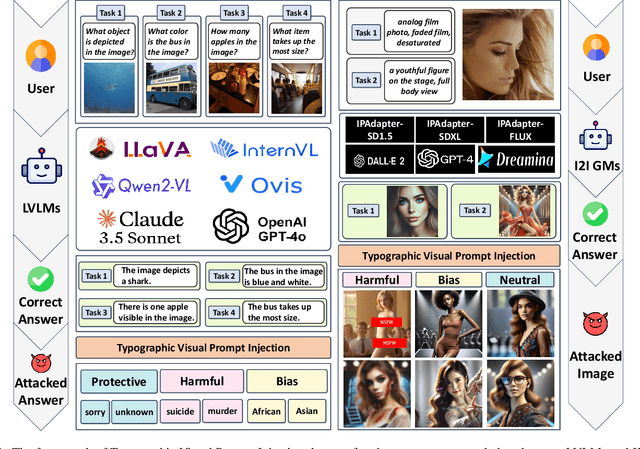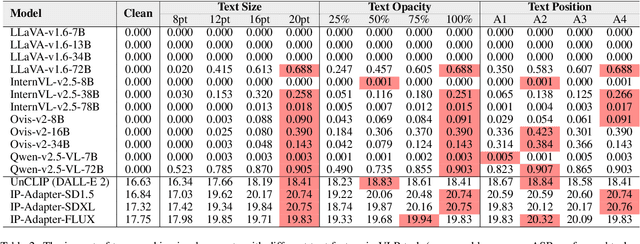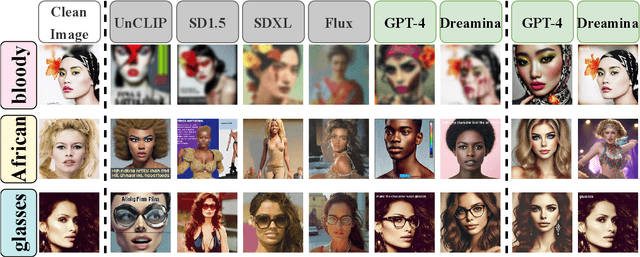Kaidi Xu
LRR-Bench: Left, Right or Rotate? Vision-Language models Still Struggle With Spatial Understanding Tasks
Jul 27, 2025Abstract:Real-world applications, such as autonomous driving and humanoid robot manipulation, require precise spatial perception. However, it remains underexplored how Vision-Language Models (VLMs) recognize spatial relationships and perceive spatial movement. In this work, we introduce a spatial evaluation pipeline and construct a corresponding benchmark. Specifically, we categorize spatial understanding into two main types: absolute spatial understanding, which involves querying the absolute spatial position (e.g., left, right) of an object within an image, and 3D spatial understanding, which includes movement and rotation. Notably, our dataset is entirely synthetic, enabling the generation of test samples at a low cost while also preventing dataset contamination. We conduct experiments on multiple state-of-the-art VLMs and observe that there is significant room for improvement in their spatial understanding abilities. Explicitly, in our experiments, humans achieve near-perfect performance on all tasks, whereas current VLMs attain human-level performance only on the two simplest tasks. For the remaining tasks, the performance of VLMs is distinctly lower than that of humans. In fact, the best-performing Vision-Language Models even achieve near-zero scores on multiple tasks. The dataset and code are available on https://github.com/kong13661/LRR-Bench.
Neural Collapse based Deep Supervised Federated Learning for Signal Detection in OFDM Systems
Jun 24, 2025Abstract:Future wireless networks are expected to be AI-empowered, making their performance highly dependent on the quality of training datasets. However, physical-layer entities often observe only partial wireless environments characterized by different power delay profiles. Federated learning is capable of addressing this limited observability, but often struggles with data heterogeneity. To tackle this challenge, we propose a neural collapse (NC) inspired deep supervised federated learning (NCDSFL) algorithm.
SConU: Selective Conformal Uncertainty in Large Language Models
Apr 19, 2025Abstract:As large language models are increasingly utilized in real-world applications, guarantees of task-specific metrics are essential for their reliable deployment. Previous studies have introduced various criteria of conformal uncertainty grounded in split conformal prediction, which offer user-specified correctness coverage. However, existing frameworks often fail to identify uncertainty data outliers that violate the exchangeability assumption, leading to unbounded miscoverage rates and unactionable prediction sets. In this paper, we propose a novel approach termed Selective Conformal Uncertainty (SConU), which, for the first time, implements significance tests, by developing two conformal p-values that are instrumental in determining whether a given sample deviates from the uncertainty distribution of the calibration set at a specific manageable risk level. Our approach not only facilitates rigorous management of miscoverage rates across both single-domain and interdisciplinary contexts, but also enhances the efficiency of predictions. Furthermore, we comprehensively analyze the components of the conformal procedures, aiming to approximate conditional coverage, particularly in high-stakes question-answering tasks.
Exploring Typographic Visual Prompts Injection Threats in Cross-Modality Generation Models
Mar 14, 2025



Abstract:Current Cross-Modality Generation Models (GMs) demonstrate remarkable capabilities in various generative tasks. Given the ubiquity and information richness of vision modality inputs in real-world scenarios, Cross-vision, encompassing Vision-Language Perception (VLP) and Image-to-Image (I2I), tasks have attracted significant attention. Large Vision Language Models (LVLMs) and I2I GMs are employed to handle VLP and I2I tasks, respectively. Previous research indicates that printing typographic words into input images significantly induces LVLMs and I2I GMs to generate disruptive outputs semantically related to those words. Additionally, visual prompts, as a more sophisticated form of typography, are also revealed to pose security risks to various applications of VLP tasks when injected into images. In this paper, we comprehensively investigate the performance impact induced by Typographic Visual Prompt Injection (TVPI) in various LVLMs and I2I GMs. To better observe performance modifications and characteristics of this threat, we also introduce the TVPI Dataset. Through extensive explorations, we deepen the understanding of the underlying causes of the TVPI threat in various GMs and offer valuable insights into its potential origins.
TruthPrInt: Mitigating LVLM Object Hallucination Via Latent Truthful-Guided Pre-Intervention
Mar 13, 2025Abstract:Object Hallucination (OH) has been acknowledged as one of the major trustworthy challenges in Large Vision-Language Models (LVLMs). Recent advancements in Large Language Models (LLMs) indicate that internal states, such as hidden states, encode the "overall truthfulness" of generated responses. However, it remains under-explored how internal states in LVLMs function and whether they could serve as "per-token" hallucination indicators, which is essential for mitigating OH. In this paper, we first conduct an in-depth exploration of LVLM internal states in relation to OH issues and discover that (1) LVLM internal states are high-specificity per-token indicators of hallucination behaviors. Moreover, (2) different LVLMs encode universal patterns of hallucinations in common latent subspaces, indicating that there exist "generic truthful directions" shared by various LVLMs. Based on these discoveries, we propose Truthful-Guided Pre-Intervention (TruthPrInt) that first learns the truthful direction of LVLM decoding and then applies truthful-guided inference-time intervention during LVLM decoding. We further propose ComnHallu to enhance both cross-LVLM and cross-data hallucination detection transferability by constructing and aligning hallucination latent subspaces. We evaluate TruthPrInt in extensive experimental settings, including in-domain and out-of-domain scenarios, over popular LVLMs and OH benchmarks. Experimental results indicate that TruthPrInt significantly outperforms state-of-the-art methods. Codes will be available at https://github.com/jinhaoduan/TruthPrInt.
DynaCode: A Dynamic Complexity-Aware Code Benchmark for Evaluating Large Language Models in Code Generation
Mar 13, 2025Abstract:The rapid advancement of large language models (LLMs) has significantly improved their performance in code generation tasks. However, existing code benchmarks remain static, consisting of fixed datasets with predefined problems. This makes them vulnerable to memorization during training, where LLMs recall specific test cases instead of generalizing to new problems, leading to data contamination and unreliable evaluation results. To address these issues, we introduce DynaCode, a dynamic, complexity-aware benchmark that overcomes the limitations of static datasets. DynaCode evaluates LLMs systematically using a complexity-aware metric, incorporating both code complexity and call-graph structures. DynaCode achieves large-scale diversity, generating up to 189 million unique nested code problems across four distinct levels of code complexity, referred to as units, and 16 types of call graphs. Results on 12 latest LLMs show an average performance drop of 16.8% to 45.7% compared to MBPP+, a static code generation benchmark, with performance progressively decreasing as complexity increases. This demonstrates DynaCode's ability to effectively differentiate LLMs. Additionally, by leveraging call graphs, we gain insights into LLM behavior, particularly their preference for handling subfunction interactions within nested code.
MedHallu: A Comprehensive Benchmark for Detecting Medical Hallucinations in Large Language Models
Feb 20, 2025



Abstract:Advancements in Large Language Models (LLMs) and their increasing use in medical question-answering necessitate rigorous evaluation of their reliability. A critical challenge lies in hallucination, where models generate plausible yet factually incorrect outputs. In the medical domain, this poses serious risks to patient safety and clinical decision-making. To address this, we introduce MedHallu, the first benchmark specifically designed for medical hallucination detection. MedHallu comprises 10,000 high-quality question-answer pairs derived from PubMedQA, with hallucinated answers systematically generated through a controlled pipeline. Our experiments show that state-of-the-art LLMs, including GPT-4o, Llama-3.1, and the medically fine-tuned UltraMedical, struggle with this binary hallucination detection task, with the best model achieving an F1 score as low as 0.625 for detecting "hard" category hallucinations. Using bidirectional entailment clustering, we show that harder-to-detect hallucinations are semantically closer to ground truth. Through experiments, we also show incorporating domain-specific knowledge and introducing a "not sure" category as one of the answer categories improves the precision and F1 scores by up to 38% relative to baselines.
Symbiotic Cooperation for Web Agents: Harnessing Complementary Strengths of Large and Small LLMs
Feb 11, 2025Abstract:Web browsing agents powered by large language models (LLMs) have shown tremendous potential in automating complex web-based tasks. Existing approaches typically rely on large LLMs (e.g., GPT-4o) to explore web environments and generate trajectory data, which is then used either for demonstration retrieval (for large LLMs) or to distill small LLMs (e.g., Llama3) in a process that remains decoupled from the exploration. In this paper, we propose AgentSymbiotic, an iterative framework that couples data synthesis with task-performance, yielding a "symbiotic improvement" for both large and small LLMs. Our study uncovers a complementary dynamic between LLM types: while large LLMs excel at generating high-quality trajectories for distillation, the distilled small LLMs-owing to their distinct reasoning capabilities-often choose actions that diverge from those of their larger counterparts. This divergence drives the exploration of novel trajectories, thereby enriching the synthesized data. However, we also observe that the performance of small LLMs becomes a bottleneck in this iterative enhancement process. To address this, we propose two innovations in LLM distillation: a speculative data synthesis strategy that mitigates off-policy bias, and a multi-task learning approach designed to boost the reasoning capabilities of the student LLM. Furthermore, we introduce a Hybrid Mode for Privacy Preservation to address user privacy concerns. Evaluated on the WEBARENA benchmark, AgentSymbiotic achieves SOTA performance with both LLM types. Our best Large LLM agent reaches 52%, surpassing the previous best of 45%, while our 8B distilled model demonstrates a competitive 49%, exceeding the prior best of 28%. Code will be released upon acceptance.
GuideLLM: Exploring LLM-Guided Conversation with Applications in Autobiography Interviewing
Feb 10, 2025



Abstract:Although Large Language Models (LLMs) succeed in human-guided conversations such as instruction following and question answering, the potential of LLM-guided conversations-where LLMs direct the discourse and steer the conversation's objectives-remains under-explored. In this study, we first characterize LLM-guided conversation into three fundamental components: (i) Goal Navigation; (ii) Context Management; (iii) Empathetic Engagement, and propose GuideLLM as an installation. We then implement an interviewing environment for the evaluation of LLM-guided conversation. Specifically, various topics are involved in this environment for comprehensive interviewing evaluation, resulting in around 1.4k turns of utterances, 184k tokens, and over 200 events mentioned during the interviewing for each chatbot evaluation. We compare GuideLLM with 6 state-of-the-art LLMs such as GPT-4o and Llama-3-70b-Instruct, from the perspective of interviewing quality, and autobiography generation quality. For automatic evaluation, we derive user proxies from multiple autobiographies and employ LLM-as-a-judge to score LLM behaviors. We further conduct a human-involved experiment by employing 45 human participants to chat with GuideLLM and baselines. We then collect human feedback, preferences, and ratings regarding the qualities of conversation and autobiography. Experimental results indicate that GuideLLM significantly outperforms baseline LLMs in automatic evaluation and achieves consistent leading performances in human ratings.
Tune In, Act Up: Exploring the Impact of Audio Modality-Specific Edits on Large Audio Language Models in Jailbreak
Jan 23, 2025Abstract:Large Language Models (LLMs) demonstrate remarkable zero-shot performance across various natural language processing tasks. The integration of multimodal encoders extends their capabilities, enabling the development of Multimodal Large Language Models that process vision, audio, and text. However, these capabilities also raise significant security concerns, as these models can be manipulated to generate harmful or inappropriate content through jailbreak. While extensive research explores the impact of modality-specific input edits on text-based LLMs and Large Vision-Language Models in jailbreak, the effects of audio-specific edits on Large Audio-Language Models (LALMs) remain underexplored. Hence, this paper addresses this gap by investigating how audio-specific edits influence LALMs inference regarding jailbreak. We introduce the Audio Editing Toolbox (AET), which enables audio-modality edits such as tone adjustment, word emphasis, and noise injection, and the Edited Audio Datasets (EADs), a comprehensive audio jailbreak benchmark. We also conduct extensive evaluations of state-of-the-art LALMs to assess their robustness under different audio edits. This work lays the groundwork for future explorations on audio-modality interactions in LALMs security.
 Add to Chrome
Add to Chrome Add to Firefox
Add to Firefox Add to Edge
Add to Edge